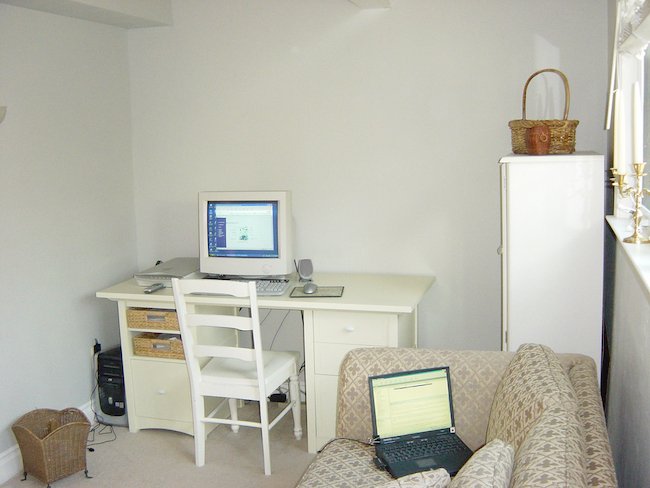Do not be afraid. Remote work and hybrid work are not new.
Everyone has an opinion on how “hybrid work” will affect business. But hybrid work (spending some time in the office and some time somewhere else) has been around for a very long time.
The concept of information workers officing from anywhere has been promoted since before home computers. Anyone around in 1992 remembers the print ads for laptops which trumpeted the benefits of working anywhere—on a flight, at home in bed, or even on the beach.
What I’m saying here is: calm down.
This is not new.
Do not panic.
Despite all the consultants, business gurus, and pundits who have An Opinion To Share, many of us have been working remote or hybrid jobs for decades.
The in-office hybrid work force
I started working “hybrid” at Wells Fargo in 2001, when I came on as a contractor to do some database work. I was in San Francisco. My boss was in Seattle. Many of the people I worked with on a daily basis were in Minneapolis.
This was 21 years ago. No Zoom (2011). No Slack (2009). No Gmail (2004).

Later, in the 2010s when I was managing the group, I was still in San Francisco. My boss was in Los Angeles. My direct reports were in Charlotte, Seattle, Phoenix, Oakland, Houston, and Minneapolis.
Even though Zoom, Slack, and Gmail all existed by then, nearly all work was still done by phone and corporate email.
On any given day, I had no idea whether someone was in their corporate office, at their home, in a café, on an airplane, in a hotel room, or at their kids’ basketball game. And it didn’t matter because they got their work done.
How that’s different from what people are calling “hybrid work” today, I can’t tell.
The only real differences I see are
- Most people now have video conferencing everywhere, and
- A lot of bosses were forced to allow remote work during the pandemic.
My early “remote work” began in 1985
In 1985 owned an Apple 2 computer with a 300 baud modem. I was a freshman at UC Berkeley and quickly discovered I could log in to the school Unix system from my apartment a mile off campus.

I did a lot of my homework and programming assignments over that 300 baud modem using the vi editor.
A guy on YouTube has recreated the experience of a 300 bps modem so you can enjoy it, too.
If you remember the movie War Games, the idea of working remotely was already in the public consciousness in 1984.
And if you don’t remember the movie, I recommend it even today. Especially if you are super excited about the wide corporate rollout of AI tech.
(Entrepreneurs are so obsessed with whether they can, they rarely pause to ask whether they should.)
All this is to say that people have been using technology to work remotely—and hybrid—for decades.
All that time, good managers have been using solid, proven management techniques to build and manage highly effective, productive, and engaged remote teams.
The only thing that’s really new is that a lot of ineffective managers have been exposed, when they no longer have control over everyone’s behavior by hovering over them in an office.
It’s like they’ve been sweeping all the dirt under a big area rug their whole careers, and someone took the rug away during the pandemic. Instead of learning how to clean effectively, though, they now demand the return of the rug.
Don’t believe anyone who has “the answer to hybrid”
Managing people well remotely is not much different from managing people all in one physical space. You need to be aware of who they are, how they work, what the team’s goals are, the team’s strategy and priorities… all the things that good managers have to do.
There are technical differences in communication and the natural rhythms of the team (I’ve written about this already)—nuances in how and when to have staff meetings, for example—but the basics of good management don’t change much.
I have to roll my eyes every time I hear some business leader quoted as saying something like “the best approach is three days in the office and two at home.”
There is no best approach.
Every person is different. We don’t all have the same upbringing, the same cultural background, the same family dynamics. We have different strengths, personality types, communication preferences.
There’s an entire industry devoted to providing assessments and methodologies for bridging those gaps.
We don’t even all spell the same words the same way.
To think that there’s one perfect approach to office presence is simply absurd, and it’s a waste of everyone’s time to argue about it.
Instead, managers and leaders need to learn how to sweep the floor without hiding all the dirt under the area rug.



1 Comment
Are my values holding me back? Am I sabotaging myself? · February 7, 2024 at 3:10 am
[…] Look, I’m not a luddite or laggard. I can be eager to adopt new technologies and ideas. For example, I embraced remote work before it was cool. In 1985, as a matter of fact. […]